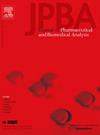Comparison of analytical-flow, micro-flow and nano-flow LC-MS/MS for sub-proteome analysis
IF 3.1
3区 医学
Q2 CHEMISTRY, ANALYTICAL
Journal of pharmaceutical and biomedical analysis
Pub Date : 2024-09-27
DOI:10.1016/j.jpba.2024.116484
引用次数: 0
Abstract
The accurate and sensitive analysis of sub-proteomic samples, such as host cell proteins (HCPs) in recombinant products and stem cells in medical devices, is crucial for ensuring product safety and efficacy in the biopharmaceutical industry. However, current analytical techniques, such as conventional analytical-flow LC-MS/MS, face limitations in sensitivity due to the low concentrations of target proteins and the complexity of the sample matrix. In this study, a highly sensitive and repeatable micro-flow LC-MS/MS strategy was developed by replacing analytical-flow tubing with micro-flow tubing on an existing analytical-flow LC-MS system for sub-proteomic sample analysis. Method optimization and evaluation were first conducted with monoclonal antibody (mAb) digestion, focusing on enhancing sensitivity and repeatability. Over 8 days, relative standard deviations (RSDs) for retention time and mass area were less than 5 % and 10 %, respectively. Sensitivity improved by 2.91–4.14 times compared to the analytical-flow LC-MS/MS method. After confirming the reliability of the method, the micro-flow LC-MS/MS method was compared to the nano-flow LC-MS/MS method and the analytical-flow LC-MS/MS method in sub-proteomic sample analysis. For HCPs, the micro-flow LC-MS/MS method demonstrated superior qualitative and much better reproducibility than the nano-flow LC-MS/MS method, with more than 98 % of proteins showing intensity RSD values below 20 %. In the analysis of mesenchymal stem cells (MSCs), the micro-flow method demonstrated good reproducibility and better sensitivity than the analytical-flow method. Taking the analysis of the 20th generation of MSC products as an example, the sample analyzed by micro-flow LC-MS/MS resulted in the identification of 68 % and 8.5 % more peptides and proteins, respectively. Moreover, micro-flow maintained stable system pressure while analyzing umbilical cord stem cells, where nano-flow methods often encounter blockages. This micro-flow LC-MS/MS method is notable for its sensitivity, reproducibility, and straightforward operation, making it highly adaptable for diverse sub-proteomic analyses in biopharmaceutical laboratories.
用于亚蛋白质组分析的分析流、微流和纳米流 LC-MS/MS 的比较
准确灵敏地分析亚蛋白质组样品,如重组产品中的宿主细胞蛋白质(HCP)和医疗器械中的干细胞,对于确保生物制药行业产品的安全性和有效性至关重要。然而,目前的分析技术,如传统的分析流式 LC-MS/MS,由于目标蛋白质浓度低、样品基质复杂,在灵敏度方面存在局限性。本研究开发了一种高灵敏度和可重复性的微流 LC-MS/MS 策略,在现有的分析流 LC-MS 系统上用微流管取代分析流管,用于亚蛋白质组样品分析。首先用单克隆抗体(mAb)消化法进行了方法优化和评估,重点是提高灵敏度和可重复性。在 8 天内,保留时间和质量面积的相对标准偏差(RSD)分别小于 5 % 和 10 %。与分析流式 LC-MS/MS 方法相比,灵敏度提高了 2.91-4.14 倍。在确认了方法的可靠性之后,微流 LC-MS/MS 方法与纳米流 LC-MS/MS 方法和分析流 LC-MS/MS 方法在亚蛋白质组样品分析中进行了比较。就 HCPs 而言,微流 LC-MS/MS 方法比纳米流 LC-MS/MS 方法具有更高的定性和重现性,98% 以上的蛋白质强度 RSD 值低于 20%。在间充质干细胞(MSCs)分析中,微流方法比分析流方法表现出良好的重现性和更高的灵敏度。以分析第 20 代间充质干细胞产品为例,采用微流 LC-MS/MS 分析的样品多肽和蛋白质的鉴定率分别提高了 68% 和 8.5%。此外,微流在分析脐带干细胞时能保持稳定的系统压力,而纳米流方法经常会遇到阻塞。这种微流 LC-MS/MS 方法灵敏度高、重现性好、操作简单,非常适合生物制药实验室进行各种亚蛋白质组分析。
本文章由计算机程序翻译,如有差异,请以英文原文为准。
求助全文
约1分钟内获得全文
求助全文
来源期刊
CiteScore
6.70
自引率
5.90%
发文量
588
审稿时长
37 days
期刊介绍:
This journal is an international medium directed towards the needs of academic, clinical, government and industrial analysis by publishing original research reports and critical reviews on pharmaceutical and biomedical analysis. It covers the interdisciplinary aspects of analysis in the pharmaceutical, biomedical and clinical sciences, including developments in analytical methodology, instrumentation, computation and interpretation. Submissions on novel applications focusing on drug purity and stability studies, pharmacokinetics, therapeutic monitoring, metabolic profiling; drug-related aspects of analytical biochemistry and forensic toxicology; quality assurance in the pharmaceutical industry are also welcome.
Studies from areas of well established and poorly selective methods, such as UV-VIS spectrophotometry (including derivative and multi-wavelength measurements), basic electroanalytical (potentiometric, polarographic and voltammetric) methods, fluorimetry, flow-injection analysis, etc. are accepted for publication in exceptional cases only, if a unique and substantial advantage over presently known systems is demonstrated. The same applies to the assay of simple drug formulations by any kind of methods and the determination of drugs in biological samples based merely on spiked samples. Drug purity/stability studies should contain information on the structure elucidation of the impurities/degradants.

 求助内容:
求助内容: 应助结果提醒方式:
应助结果提醒方式:


